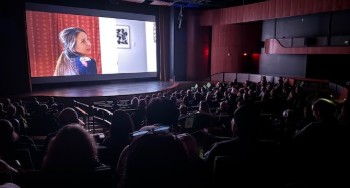By Deron Hamel
Under the Lights is a feature-length film about a high-school student named Sam (played by Pearce Joza) who is living with epilepsy. Sam is so desperate to live a life like other teenagers he attends his prom – even though he knows the lights in the auditorium will likely cause him to have a seizure.
The film was written and directed by Miles Levin, a California-based filmmaker who is living with epilepsy. Initially released as a 10-minute short film in 2020, the response was so favourable that Levin decided to make a full-length feature, which was released in September. The film is on the film-festival circuit and, to date, has received 12 awards.
Under the Lights also stars Lake Bell, Nick Offerman, Marin Hinkle, Randall Park and Peter Coyote.
Voices of Epilepsy recently spoke with Levin about the film.
Voices of Epilepsy: What motivated you to make Under the Lights?
Miles Levin: I have epilepsy, and I started to notice that when people talk about their epilepsy, their seizures are just part of the story. Usually we focus only on the seizures. What really makes life hard is the time between seizures. Whether they’re having a seizure or not, people live with epilepsy every second of the day. They’re afraid to form lasting relationships, afraid to ask for accommodations because they might lose everything – and that’s what I credit the high suicide and depression rates to.
All of this is solvable. Other marginalized groups have made progress through storytelling – by putting their authentic selves on screen. Cinema is the one place where people actually want to see something new. At awareness events, we’re often just talking to those who already understand. The people we need to reach won’t come to those events. You can’t educate them into submission – you have to entertain them.
So I thought: what if the point of reference for epilepsy wasn’t a hospital show or a horror movie, but Sam — a boy who’s so desperate to feel normal that he goes to prom knowing the lights might make him have a seizure? What if that’s what people thought of when they thought of epilepsy?
VoE: What has the response been like to the short and full-length film?
ML: The response was incredible. There was fan art from around the world. People messaged me saying they were seizure-free after being motivated to see their doctor again. Others went into medicine because they took an interest in epilepsy. It was staggering. So I thought – short films are great, but this one had more life in it. We had to make a feature. We put together an incredible cast and created what I think will be the biggest moment for epilepsy awareness of all time.
VoE: Have there been any particular reactions to the film that stand out for you?
ML: For many people, they feel that epilepsy is something they can’t talk about. And when they see somebody else talking about it and they look around for the response and they see that that person didn’t get beat up or called out online or treated poorly, they feel motivated to do it themselves and it creates a chain reaction. So when someone sends me a song about their epilepsy or about the characters in the movie, or when someone tells me they’re going to start writing a book, or that people have changed their career path – students have done their college projects on this – that’s a huge deal. It is making life a little easier for some people.
VoE: Are there any aspects of living with epilepsy that you wanted to convey on the screen?
ML: Many people who have epilepsy feel misunderstood. They are looked at like they are an outcast. It means people will have assumptions about you that are uncalled for. In the short and in the feature film we go over that. We show the impact on the caregiver, which is another untold story. The people who suffer silently keep the person in question afloat. I tried to do this in a fashion that is universal, where we focus on the feeling, on the emotion that comes with all of this because they might not know what it’s like to have epilepsy, but they know what it’s like to feel left out and misunderstood. If they make that connection, they’re going to be way more likely to sit and listen to the symptoms and be more interested in seizure first aid and all these other goals that we want to achieve. Any epilepsy organization will tell you it’s really hard to force these things on the audience, so let’s convince people to get together and listen to information that they would not have pursued themselves. It’s hard to do, but if you can have a movie night people will turn out.
VoE: What are your thoughts on how well-received the film has been as a full-length movie?
ML: It’s really, really amazing. When you’re sitting on a short film for so many years it’s easy to worry and to wonder if all this effort will pay off. But when I am standing at an event and there are 400 people lined up around the block to see my film, it’s a tremendous victory and it’s very, very meaningful.
To learn when Under the Lights is coming to your area, or for updates on the film, you can sign up on the movie’s website.
You can also learn more about Under the Lights on the movie’s Facebook and Instagram pages.







